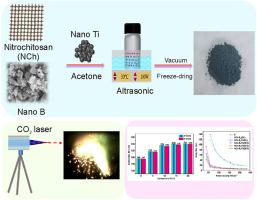NCh-B和NCh-B- ti纳米复合材料的制备及其点火燃烧性能
IF 3.9
Q2 CHEMISTRY, MULTIDISCIPLINARY
引用次数: 0
摘要
为了克服纳米硼(n-B)粉团聚和燃烧不充分的问题,本研究利用声共振技术成功制备了两种新型的硼基纳米复合材料,即高替代亚硝基壳聚糖/纳米硼(NCh-B)(比例分别为1:3、1:5、1:7和1:9)和亚硝基壳聚糖/纳米硼粉/纳米钛(NCh-B-Ti)(钛含量分别为5wt %、10wt %、15wt %和20wt %)。系统地研究了复合材料的结构形态、激光点火性能和燃烧性能。结果表明,NCh的加入能显著改善n-B的色散。NCh-B的燃烧性能优于n-B,其燃烧延迟和火焰面积均优于n-B。当激光功率密度为81 W时,NCh-B5- ti15%的燃烧时间和点火延迟分别为240 ms和5.5 ms,高于NCh-B5 (199 ms和17 ms)。NCh-B5-Ti15%比n-B粉末(12 ms)和NCh-B粉末(11 ms)具有更低的点火延迟,火焰更亮,燃烧面积更大。因此,n-Ti的加入可以促进n-B粉末的燃烧,NCh-B-Ti的燃烧产物包括H3BO3、B2O3、TiB2和TiO。该研究为提高n-B粉末的点火性能和燃烧效率提供了一种新的方法。本文章由计算机程序翻译,如有差异,请以英文原文为准。


Preparation of NCh-B and NCh-B-Ti nanocomposites and their ignition and combustion performances
To overcome the agglomeration and insufficient combustion of nano-boron (n-B) powders, this study successfully prepared two novel types of boron-based nanocomposites using the acoustic resonance technology, namely high-substitute nitrochitosan/nano-boron (NCh-B) with ratios of 1:3, 1:5, 1:7 and 1:9, and nitrochitosan/nano-boron powder/nano-titanium (NCh-B-Ti) with Ti contents of 5 wt%, 10 wt%, 15 wt% and 20 wt%. The structural morphologies, laser ignition and combustion properties of the composites were systematically investigated. The results suggest that the addition of NCh can significantly improve the dispersion of n-B. NCh-B exhibited a higher combustion performance than n-B, as evidenced by their ignition delay and flame areas. When the laser power density was 81 W, NCh-B5-Ti15% exhibited a combustion time and an ignition delay of 240 ms and 5.5 ms respectively, which were higher and lower than those of NCh-B5 (199 ms and 17 ms, respectively). Furthermore, NCh-B5-Ti15% displayed a lower ignition delay than both n-B powders (12 ms) and NCh-B (11 ms), as well as brighter flames and a larger combustion area. Therefore, the addition of n-Ti can promote the combustion of n-B powders, with the combustion products of NCh-B-Ti including H3BO3, B2O3, TiB2, and TiO. This study provides a new method for improving the ignition performance and combustion efficiency of n-B powders.
求助全文
通过发布文献求助,成功后即可免费获取论文全文。
去求助
来源期刊

Energetic Materials Frontiers
Materials Science-Materials Science (miscellaneous)
CiteScore
6.90
自引率
0.00%
发文量
42
审稿时长
12 weeks
 求助内容:
求助内容: 应助结果提醒方式:
应助结果提醒方式:


